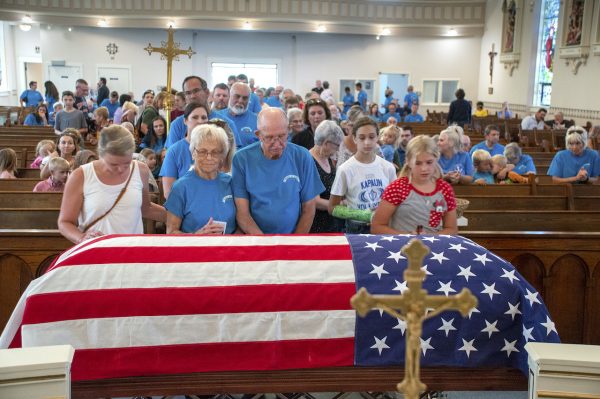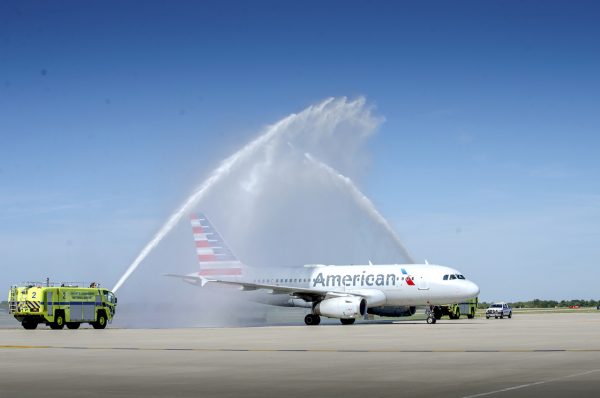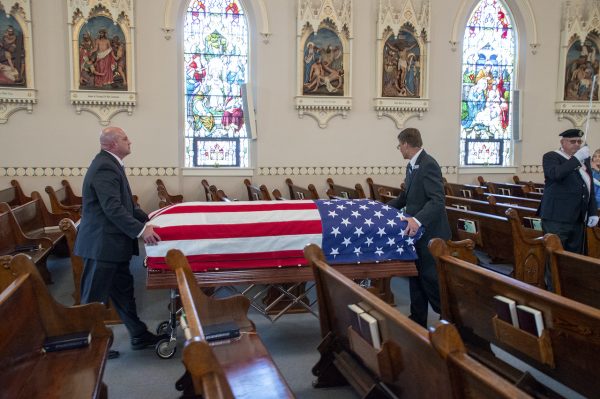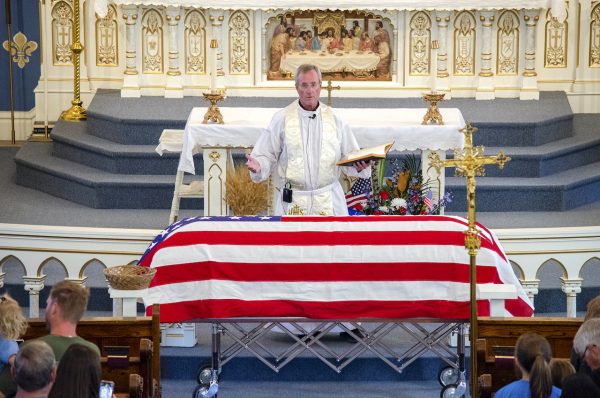Fr. Emil Kapaun returns home to Kansas

A military honor guard prepares to carry the remains of Fr. Emil Kapaun from a flight originating in Honolulu to a hearse for a trip to Father’s hometown of Pilsen, Kansas. (Advance photo)
Fr. Emil J. Kapaun is home.
The saga of his return began with a send-off Mass celebrated Thursday evening, Sept. 23, at the Cathedral Basilica of Our Lady of Peace in Honolulu.
The bishops and priests concelebrating the Mass processed into the cathedral wearing leis, a symbol of love, friendship, celebration, honor, or greeting.
After the remains were blessed by the Most Rev. Larry Silva, bishop of the Diocese of Honolulu, Fr. Kapaun’s casket was draped with a priest’s pall in front of the altar near an Easter candle, a folded and encased U.S. flag, flowers, and plants.
Fr. Wayne Schmidt, a retired priest of the Diocese of Wichita, delivered the homily after thanking all of those involved in transferring Fr. Kapaun’s remains and Bishop Silva for his hospitality.
“If I were to give a title to this homily, or even a summation, I would say it would be titled ‘Father Kapaun, a saint for our times and also a priest flowing with the love of God.’”
He is a man to be emulated by civilian priests and by chaplains, Protestant or Catholic, Fr. Schmidt said, because he ministered to all regardless of their denomination.

Ray Kapaun, nephew of Army chaplain and Medal of Honor recipient, Capt. Emil J. Kapaun, touches his uncle’s place mark at the National Memorial Cemetery of the Pacific, Honolulu, Hawaii, June 15, 2021. Capt. Kapaun received the highest award for military valor for the actions he took to protect the lives of his fellow soldiers while imprisoned in a prisoner of war camp. (U.S. Air Force photo by Staff Sgt. James Thompson).
Fr. Schmidt mentioned Msgr. Arthur Tonne’s book: The Story of Chaplain Kapaun, Patriot Priest of the Korean Conflict, which he read as a high school sophomore in 1956 for a book report.
“And being a boy of that age, kind of immature, not much of a student, I had to have something that would excite me,” he said. “Well, that aroused my curiosity. I opened a book and I haven’t quit using it for over 80 years of life.”
Fr. Schmidt said he used the book during his 52 years as a priest and his 24 years and seven months as a U.S. Army chaplain.
“He has had that influence on my life,” he said. “And the reason he had such an influence on my life, and what attracted me, was the way he lived his life totally and completely other-centered. No task was too low for him to take on.”
Fr. Kapaun exercised humility throughout his life, he said, not just as a chaplain on the battlefield. “When you read this book, it’s almost like reading a new gospel because it’s composed of letters – the words of fellow POWs and people who encountered him on a battlefield, and to a man, they say the same thing: he was like Christ to them.”
Fr. Kapaun was called to put on Christ, to be Christ when he was baptized, Fr. Schmidt said, adding that when Fr. Kapaun was called to be a priest he was given the special gift to be Christ’s presence wherever he was sent.
“It didn’t matter to him whether you were a Jew, a Catholic, a Muslim, an atheist, or someone who they didn’t know who they were. He treated them equally.”
We would all do well to emulate Fr. Kapaun, he said, because saints are models for us.
Fr. Schmidt said after he, personally, had some challenges getting into a seminary, his pastor asked him if he still wanted to become a priest. “He called Bishop Carroll and Bishop Carroll said ‘I will take him.’ It wasn’t easy, but that’s a whole other story.”
Fr. Schmidt said the first words out of his mouth after he was ordained and when he had an audience with the bishop were: “When can I be a chaplain. Three and a half years later I was a chaplain.”
He said he believes Fr. Kapaun accompanied him throughout his career as a chaplain. “Father Kapaun ministered as Christ ministered. He lived as Christ called us to live.”
Fr. Schmidt said he believes Fr. Kapaun knew Christ was “with him always” because of the way he died – he was fearless.
Fr. Kapaun said when he was near death that his tears were tears of joy.
“When he was taken to that death camp he told one of his fellow POWs: ‘If I don’t make it back, tell the bishop that I died a happy death.’ That can only come from a man of deep and committed faith, who believed that he lived to his last breath, in the presence of Christ in the world in which he was given.”
Bishop Kemme comments at the Hawaiian Mass
Bishop Kemme thanked Bishop Silva at the end of the Mass for his hospitality and for all those involved in assisting the Diocese of Wichita’s efforts to begin moving Fr. Kapaun’s remains.
“Thank you most of all for suggesting to have this Mass and arranging it,” he said to Bishop Silva. “What a wonderful experience to be able to send us back to Kansas, with the grace of this sacrament.”
Bishop Kemme said it was difficult for him to express the emotions he has felt while in Hawaii, feelings that began last March with the announcement of the discovery of Fr. Kapaun’s remains.
He said he was humbled that six of his predecessors would have longed for that day, “especially Bishop Carroll who allowed Father Kapaun to go off the second time to be a military chaplain, but did not see him return.”
The diocese is grateful for the answer to our prayers, he said.
Many will be eagerly waiting Saturday afternoon when the plane lands in Wichita with Fr. Kapaun’s remains, Bishop Kemme said.
“I believe we have prepared a worthy hero’s welcome for Father Emil Kapaun who was truly a hero. And certainly, that is true for us in Wichita, Kansas, but it’s now true all over the world.”
Bishop Kemme said it was with joy that the contingent from Wichita accompany the family as they take Fr. Kapaun home to Kansas, where he was born, where he was baptized and ordained, and from where he was sent to be a missionary.
“This is my first time in Hawaii,” he said. “I hope it’s not my last. Hawaii and Kansas have literally nothing in common – except both are the lands of saints. And we have worked very hard, and will continue to work very hard, to prove to Holy Mother Church that Kansas has a true saint in Father Emil Kapaun.”
For 63 years Hawaii has had who the Diocese of Wichita believes was a saint in your midst, Bishop Kemme said, adding that it is believed he is a powerful intercessor.
“And we can only pray that as we take him, his mortal remains back with us to Kansas tomorrow, that you will experience here in the Diocese of Honolulu, in the state of Hawaii, and beyond – his powerful intercession.”
Viewing the remains in Hawaii
The entourage from the Diocese of Wichita visited the Defense POW/MIA Accounting Agency Tuesday, Sept. 21, after a morning Mass at the St. Stephen Diocesan Center. It is located at the Joint Base Pearl Harbor-Hickam which is adjacent to Daniel K. Inouye International Airport in Honolulu.
Ray Kapaun and his wife, Lee, Bishop Carl A. Kemme, Fr. David Lies, Fr. Wayne Schmid, and Scott Carter were escorted by Johnie Webb, deputy director of Outreach & Communications, to the Family Viewing Roome to see Fr. Kapaun’s remains before he began his journey home.
“We were able to view the remains and prayed the prayers for Gathering in the Presence of a Body,” Carter said. “It was a powerful moment. All of us were super-touched to be there in the presence of a man who could be a saint along with his family.”
He said all of those present have a spiritual knowledge of Fr. Kapaun but to be with his remains “took things to another level. We’re definitely excited to bring him home.”
After spending some time there, the family placed a blanket over Fr. Kapaun and a U.S. flag was draped over the casket.
Carter said about 50 employees of the facility lined one side of a walkway and about 50 military lined the other side as the remains, accompanied by military representatives, were ceremonially moved from the facility to a hearse.
“That’s when tears started coming,” Carter said, “seeing how much of an impact he had on the staff and the military here. They’ve come to know and love what he did for his fellow prisoners.”
After a salute, the remains were placed into the hearse for Fr. Kapaun to begin his journey back to Kansas.
In addition to some sight-seeing, a documentary video crew hired by the diocese interviewed Dr. Jennie Jin, a Defense POW/MIA Accounting Agency forensic anthropologist,whose grandfather was a North Korean refugee.
Fr. Kapaun’s journey began in March at Ray Kapaun’s home in Whidbey Island in Washington State when he was notified by telephone that the remains of his uncle has been identified.
Ray said he was more surprised to learn about Fr. Kapaun’s remains than he would have been if he had told Fr. Kapaun’s cause for canonization had moved forward.
Ray Kapaun flew to Hawaii in June to initiate Fr. Kapaun’s journey home.
Visiting the Punchbowl
The entourage from the Diocese of Wichita on Wednesday, Sept. 22, visited the National Memorial Cemetery of the Pacific, the national cemetery located at Punchbowl Crater in Honolulu.
“It’s an incredible geological feature, a volcanic crater, where the cemetery is located,” Carter said.
They visited the Courts of the Missing that features Fr. Kapaun’s name. The names of 28,788 military personnel missing in action or were lost or buried at sea in the Pacific during World War II, and the Korean and Vietnam wars, are listed on marble slabs in ten Courts of the Missing, which flank the Memorial’s grand stone staircase.
“Fr. Kapaun’s name really pops out because it’s in gold lettering because he’s a Medal of Honor recipient,” he said.
Ray later place a rosette next to his name indicating that Father’s remains had been relocated from the Punchbowl. They also visited the location of where his remains were buried after they were moved from North Korea.
“Father David (Lies) commented that we believe in the resurrection of the body and related that to the empty grave of Fr. Kapaun,” he said.
 Mass in Pilsen
Mass in Pilsen
Bishop Carl A. Kemme said during a homily Sunday, Sept. 26, in Pilsen that God put the desire of the priesthood in Emil Kapaun’s heart at an early age.
“That thought was no doubt supported and encouraged by his parents, his pastor, and the religious sisters responsible for his education,” he said. “It seems no one was surprised by this desire.”
Fr. Kapaun was ordained in 1940, Bishop Kemme said. “A happy day for the Kapaun family and for his parish in Pilsen.”
Speaking to a packed St. John Nepomucene Church on yet another beautiful fall day, Bishop Kemme described Fr. Kapaun’s life like many facets of a brilliant diamond.
“One could rightly recall, especially here, Emil’s early years, his relationship with his parents, his dedication to hard work, even his simple way of life. Here young Emil Kapaun grew into the man God needed him to be, a man of virtue and values, hard work and determination.”
Reminding the faithful that the day was also Priesthood Sunday, the bishop said that on ordination day no priest knows how God will use him for his divine purposes.
“Young Father Kapaun was no different. But like all of us, he laid down his life and surrendered his will to the will of the church, as best expressed in the office of his bishop,” Bishop Kemme said.
After beginning his priestly service at St. John Nepomucene, he said, Fr. Kapaun soon felt the call to serve Christ’s sheep in the armed forces.
“From there, of course, we know the rest so very well. But it was his priesthood that was the foundation of his service to the soldiers he supported. He was Chaplain Fr. Kapaun and as a priest, he became a spiritual father to those men in a way that changed their lives.”
More priests like Fr. Kapaun are needed, Bishop Kemme said. “Priests who are not afraid to roll up their sleeves and work diligently for the needs of the people entrusted to their care. We need priests to live moral and virtuous lives that are clearly evident, to put the needs of the flock of Christ before their own.”
Bishop Kemme said Fr. Kapaun has inspired by Fr. Kapaun.
“One of the emotions I felt so strongly – and still do as I was so honored to view the remains of this humble and holy priest while in Hawaii – is that I need to step up my game when it comes to my own living of the priestly life,” he said.
“I need to renew my own priesthood as I live it now in the office of bishop so that my actions, both seen and unseen, are steeped in the quality of self-giving and self-sacrifice that was so evident in the life and ministry of Father Kapaun.”
He added that he hopes that same grace anoints the hearts of all the priests of the diocese.
Bishop Kemme closed his homily by asking for Fr. Kapaun’s intercession to inspire more young men to consider a call to the priesthood.
“May they see Father Kapaun as a worthy model of the priesthood, for in my humble judgment they can find none better. “
About Fr. Kapaun
Fr. Kapaun was known for risking his life on the battlefield during the Korean War to minister to the troops on the front line. He was taken a prisoner of war in November of 1950, enduring brutal captivity where he continued to serve and bolster the morale of fellow prisoners. Fr. Kapaun died in a prison camp on May 23, 1951. He was awarded the Medal of Honor in 2013 for his heroic actions on the battlefield.
Fr. Kapaun’s remains were among the 4,200 sets of remains returned to the United States in 1954. They were interred in National Memorial Cemetery of the Pacific, known as the Punchbowl, on Oahu Island. The remains were among those dug up in 2019 and sent to the laboratory to utilized DNA to identify remains.
In 1993, Father Emil Kapaun was named a Servant of God, signifying that his cause for sainthood could begin. A thorough investigation into his life was conducted by the Diocese of Wichita and the details presented to the Congregation for Saints in Rome, where his cause awaits review on the path to what we pray will be his eventual beatification and canonization.
The Defense POW/MIA Accounting Agency is an agency within the United States Department of Defense whose mission is to recover United States military personnel who are listed as prisoners of war or missing in action from designated past conflicts, from countries around the world.
For more information on Fr. Kapaun’s story and his cause for canonization visit www.frkapaun.org.



